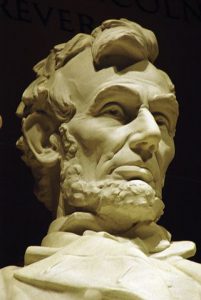Saturday
Arts and PoetryLincoln in the Bardo
review of a George Saunders novel
by Michelle Welch
 I’m often on the lookout for Buddhist-themed novels, and Lincoln in the Bardo is a new novel that received numerous critical accolades. More recently, Lion’s Roar magazine featured an interview with the author, George Saunders. I was particularly drawn to the novel after I attended a sukhavati ceremony, which is intended to help a deceased person in their passage through the bardo. In Tibetan Buddhist thought, the bardo is an intermediate state where the deceased await rebirth.
I’m often on the lookout for Buddhist-themed novels, and Lincoln in the Bardo is a new novel that received numerous critical accolades. More recently, Lion’s Roar magazine featured an interview with the author, George Saunders. I was particularly drawn to the novel after I attended a sukhavati ceremony, which is intended to help a deceased person in their passage through the bardo. In Tibetan Buddhist thought, the bardo is an intermediate state where the deceased await rebirth.
Lincoln in the Bardo is inspired by the true story of Abraham Lincoln visiting his young son’s crypt after the boy’s sudden illness and death. Placed in 19th-century America, the ghosts who populate the novel – befriending the newly arrived Willie Lincoln and watching his father’s visits – would know nothing of Tibetan Buddhism. Their intermediate state is not a waiting place for rebirth, but for a final judgment that will send them to the Christian heaven or hell.
 Still, Buddhist themes find their way into the story, as Buddhist author Saunders acknowledges. The ghosts are reluctant to admit that they’re dead, and are even more unwilling to move on to the next stage and face their judgments. To remain in the intermediate state, they continually retell the stories of their lives to anyone who will listen – a suggestion of what Pema Chödrön calls the storyline, which causes us suffering until we can drop it.
Still, Buddhist themes find their way into the story, as Buddhist author Saunders acknowledges. The ghosts are reluctant to admit that they’re dead, and are even more unwilling to move on to the next stage and face their judgments. To remain in the intermediate state, they continually retell the stories of their lives to anyone who will listen – a suggestion of what Pema Chödrön calls the storyline, which causes us suffering until we can drop it.
 The suggestion of Buddhist thought becomes even clearer when the novel looks at Abraham Lincoln’s thoughts as he struggles to overcome his grief. He acknowledges that he expected his son’s life to be a fixed thing, and that he suffers because it proved to be impermanent. He goes on to express a sense of compassion for all beings who suffer: “All were in sorrow, or had been, or soon would be… At the core of each [person] lay suffering… His sympathy extended to all in this instant…” The novel offers a fascinating and moving combination of Buddhist ideas in the context of its historical setting.
The suggestion of Buddhist thought becomes even clearer when the novel looks at Abraham Lincoln’s thoughts as he struggles to overcome his grief. He acknowledges that he expected his son’s life to be a fixed thing, and that he suffers because it proved to be impermanent. He goes on to express a sense of compassion for all beings who suffer: “All were in sorrow, or had been, or soon would be… At the core of each [person] lay suffering… His sympathy extended to all in this instant…” The novel offers a fascinating and moving combination of Buddhist ideas in the context of its historical setting.
Editor’s note: the Shambhala Times welcomes submissions of reviews, especially of books, music, and films that incorporate Buddhist ideas and/or that you find helpful in supporting your practice. Just click on the “Submissions” link at the top of the main page for the Times, or send your review as an email attachment addressed to [email protected] — we look forward to hearing from you!




